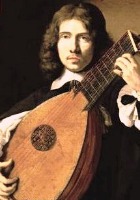Thomas Campion Biography
Thomas Campion (sometimes Campian) (12 February 1567 – 1 March 1620) was an English composer, poet, and physician. He wrote over a hundred lute songs, masques for dancing, and an authoritative technical treatise on music.
Life
Campion was born in London, the son of John Campion, a clerk of the Court of Chancery, and Lucy (née Searle – daughter of Laurence Searle, one of the queen's serjeants-at-arms). Upon the death of Campion's father in 1576, his mother married Augustine Steward, dying soon afterwards. His step-father assumed charge of the boy and sent him, in 1581, to study at Peterhouse, Cambridge as a "gentleman pensioner"; he left the university after four years without taking a degree. He later entered Gray's Inn to study law in 1586. However, he left in 1595 without having been called to the bar.
On 10 February 1605, he received his medical degree from the University of Caen.
Campion is thought to have lived in London, practicing as a physician, until his death in March 1620 – possibly of the plague. He was apparently unmarried and had no children. He was buried the same day at St Dunstan-in-the-West in Fleet Street.
He was implicated in the murder of Sir Thomas Overbury, but was eventually exonerated, as it was found that he had unwittingly delivered the bribe that had procured Overbury's death.
Poetry and songs
The body of his works is considerable, the earliest known being a group of five anonymous poems included in the "Songs of Divers Noblemen and Gentlemen," appended to Newman's edition of Sir Philip Sidney's Astrophel and Stella, which appeared in 1591. In 1595, Poemata, a collection of Latin panegyrics, elegies and epigrams was published, winning him a considerable reputation. This was followed, in 1601, by a songbook, A Booke of Ayres, with words by himself and music composed by himself and Philip Rosseter. The following year he published his Observations in the Art of English Poesie, "against the vulgar and unartificial custom of riming," in favour of rhymeless verse on the model of classical quantitative verse. Campion's theories on poetry were demolished by Samuel Daniel in "Defence of Rhyme" (1603).
In 1607, he wrote and published a masque for the occasion of the marriage of Lord Hayes, and, in 1613, issued a volume of Songs of Mourning: Bewailing the Untimely Death of Prince Henry, set to music by John Cooper (also known as Coperario). The same year he wrote and arranged three masques: The Lords' Masque for the marriage of Princess Elizabeth; an entertainment for the amusement of Queen Anne at Caversham House; and a third for the marriage of the Earl of Somerset to the infamous Frances Howard, Countess of Essex. If, moreover, as appears quite likely, his Two Bookes of Ayres (both words and music written by himself) belongs also to this year, it was indeed his annus mirabilis.
In 1615, he published a book on counterpoint, A New Way of Making Fowre Parts in Counterpoint By a Most Familiar and Infallible Rule, a technical treatise which was for many years the standard textbook on the subject. It was included, with annotations by Christopher Sympson, in Playford's Brief Introduction to the Skill of Musick, and two editions appear to have been published by 1660.
Now winter nights enlarge
This number of their hours;
And clouds their storms discharge
Upon the airy towers.
...
There is a garden in her face
Where roses and white lilies grow;
A heav'nly paradise is that place
Wherein all pleasant fruits do flow.
...
There is a garden in her face
Where roses and white lilies blow;
A heavenly paradise is that place,
Wherein all pleasant fruits do flow:
There cherries grow which none may buy
...
NEVER weather-beaten sail more willing bent to shore,
Never tired pilgrim's limbs affected slumber more,
Than my wearied sprite now longs to fly out of my troubled breast:
O come quickly, sweetest Lord, and take my soul to rest!
...
THE man of life upright,
Whose guiltless heart is free
From all dishonest deeds,
Or thought of vanity;
...
